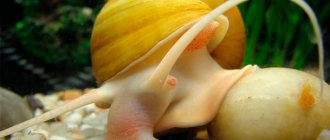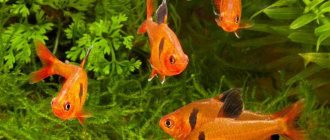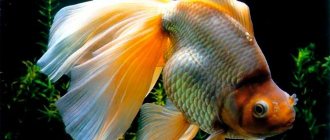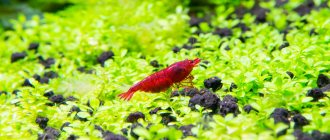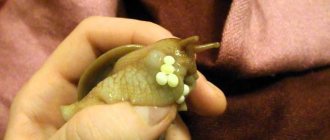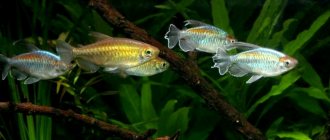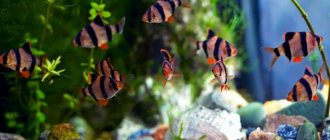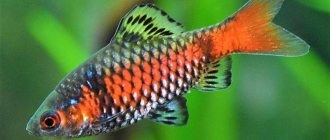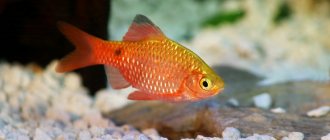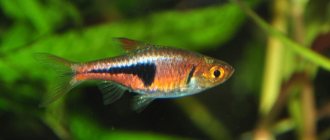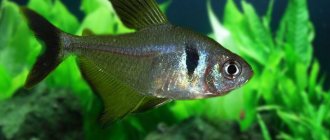Sumatran barb
The aquarium fish Sumatran barb (Puntigrus tetrazona) is found in natural standing and flowing reservoirs of Sumatra, Borneo and Kalimantan (Indonesia). They appeared in the USSR after World War II. The body is elliptical, laterally compressed. The color is golden, with 4 vertical black stripes, the scales are shiny. The fins are transparent, with a reddish tint. They grow up to 6–7 cm. In aquariums they reproduce actively if the conditions of keeping are observed.
- Ambient temperature: 21–25 °C. The barb can withstand temperatures down to 15 °C, but there will be no intense colors, interesting behavior or reproduction.
- Acidity: pH 6–7.
- Hardness: 1–5 °F.
Weekly change 1/4–1/3 of the water in the vessel. Filtration is required, air purging is desirable. In captivity they live 3–4 years.
Description and characteristics
Both an experienced aquarist and a beginner can start breeding barbs. To do this, you need to familiarize yourself with the characteristics of the species, the rules of maintenance and spawning, and also provide proper care for the newly born fry.
The habitat of the barb is Southeast Asia, Africa. There are 200 species of barbs in nature, but 30 species living in Southeast Asia are popular among aquarists.
- Class: Ray-finned;
- Family: carp;
- Genus: barbs.
The appearance of the fish depends on its variety. The most popular in the aquarium hobby are:
- Rainbow;
- Gracilis;
- Solar;
- Clown;
- Mutant;
- Cross;
- Six stripe;
- Sumatran (tiger).
The Sumatran barb has been very popular among breeders for several decades. This is explained by their unusual color, reminiscent of a tiger skin, and the fact that they are not picky about breeding conditions.
These are heat-loving creatures that prefer to be in water whose temperature is not lower than 22С. Barbs love cleanliness, so the water in the aquarium should be changed daily by 20%.
Differences between a female and a male
Sexual dimorphism is weakly expressed. It is impossible to determine the sex of a barb before puberty. The female can be distinguished by its larger size (5–7 mm in length) and enlarged abdomen. The coloring of the male is contrasting, the jaws are intensely orange.
The posterior edge of the anal fin of the female is inclined relative to the base of the tail by 60–90°. Males - at 30–45°.
Possible problems
The process of breeding Sumatran barbs can be accompanied by diseases:
- redness of the gills (the bases of the fins);
- the appearance of mucus on the scales, sticking of fins, lethargy.
Such symptoms are possible due to infection of the fish with ectoparasites and are eliminated by treating the fish with antibiotics, methylene blue, and placing it in salt baths for a short time. During the treatment period, the barb is left in the spawning area.
When planning to breed Sumatran puntius and obtain offspring from them, purchase individuals of three months of age, when it is already possible to distinguish a female from a male. Please note that it is advisable to buy the number of male and female fish in a ratio of 2:1, respectively.
- Related Posts
- Mutant or mossy barb? What kind of fish is this?
- Odessa or Scarlet Barb
- The velvety splendor of the black barb: features and conditions of detention
Cooking fish
Isolate males from females for 1-2 weeks, but do not delay. Overexposed males fight. Females that lack the ability to mark become ill. Feed barbs preparing to breed with live or frozen food. 1/3 of the diet - oatmeal (Hercules), tablets with spirulina. The day before spawning is a fasting day.
Males ready for spawning are aggressive. Pregnancy of a female is determined by a swollen abdomen and a swollen anus. The photo above shows a female suitable for spawning.
Start with selecting manufacturers. Choose regular sized barbs. Defects in body structure and color are unacceptable.
Which manufacturers to choose
Sumatran red and striped barbs are schooling fish. However, group spawning at home is usually ineffective for them. Therefore, for breeding, the aquarium owner will have to choose the two healthiest and most beautiful producers - a male and a female. It is believed that fairly nimble, but not too aggressive, medium-sized barbs are suitable for spawning.
You can, of course, try to reproduce these fish in a group way. In this case, the spawning area should ultimately contain 50% females and 50% males.
Of course, weakened Sumatran barbs, sick, too small, or with developmental defects should not be allowed to spawn. It will be impossible to obtain high-quality caviar from such fish. In addition, the fry from such producers will subsequently hatch sick and non-viable.
Reproduction at home
Spawning of barbs is stimulated by adding soft water and raising the temperature by a couple of degrees. The pregnant female moves actively, the male follows her, patting her on the sides and knocking out the eggs. The eggs rush into the water column, where they are fertilized by the male.
In a separate spawning area
Spawning aquarium - 10–15 liters per couple. The water column is 15–20 cm. A “trough” type vessel is suitable. Plants floating in the water column (hornwort, monosolenium, Java moss) will help the female periodically take a break from the annoying male and will be useful to the fry.
Prepare the water according to the following calculation: add 2/3 aquarium water and 1/3 spawning water with fresh settled water or by osmosis (recommended). Maintain the temperature at 28 °C. Aeration, filter and illumination are not required until the eggs appear.
The bottom of the spawning jar is covered with a separator net. A significant part of the eggs after spawning will pass through the grate and will not be eaten by the parents. The rest will stick to the netting and plants.
Spawning usually begins immediately after the selected pair has landed. Marking occurs at night and is completed by morning unless artificial darkness is applied.
If you can’t use a separator, cover the bottom with mosses and ferns. Eggs entangled in the greenery will be safe after spawning.
Soil in the form of large glass balls will protect failed eggs. The part will stick to the surface and is in danger.
Advantage of using a grid:
- most of the caviar is preserved;
- the ability to remove unfertilized eggs;
- the ability to quantify the label.
In a common aquarium
Most of the barb eggs and fry will be eaten. Producers do not protect their offspring. The chances of eggs and fry surviving are increased in herbal beds with an abundance of ground cover plants (Echinodorus), ferns and mosses on the bottom. The offspring should be provided with food, “living dust”. The only plus is that strong and fast individuals with good reactions survive.
Keep an eye out for pregnant barbs. Unswept eggs lead to cyst growth and the death of the fish.
Caviar yield
Barbs are quite prolific fish. The yield of fry from their eggs, depending on the water parameters and the quality of the producers, can reach 50-90%. In any case, unfertilized fish “eggs” will need to be removed from the spawning aquarium. Such caviar differs from fertilized caviar in white color. After adding methylene blue to the water, it will become clearly visible.
It is imperative to remove unfertilized eggs from the spawning tank, at least partially. Otherwise, fungus will begin to develop on it. And this, in turn, can lead to infection of the fertilized eggs and death of the fry.
After finishing
- After marking is complete, place the barbs in a community aquarium. The female is removed from the remains of eggs, which threaten cyst formation, by lightly stroking the abdomen in the direction of the anus.
- Reduce the water column to 10–12 cm. Change 1/4–1/3 of the water.
- To prevent fungal diseases, treat the vessel with liquid methylene blue (C16H18ClN3S). For disinfection, it is sufficient for the medium to acquire a faint blue color. Start air purge.
- After 10–12 hours, remove the separator from adhering eggs and remove. Remove unfertilized white eggs (they are transparent with the offspring).
Important
After spawning, the remaining eggs of the female Sumatran barb must be squeezed out. To do this, you need to stroke the fish towards the anus, lightly squeezing it with two fingers. If this procedure is neglected, the female may subsequently develop a cyst, which will make her unable to reproduce.
Of course, it is absolutely impossible to transplant breeding barbs from a spawning tank into a general aquarium. The fish must first be adapted to other environmental parameters in a standard way. The temperature in the general aquarium is usually lower than in the spawning tank.
Content
The fry hatch within 24–30 hours. After 3–4 days they begin to move and feed. Start lowering the temperature by 1 °C per week to the temperature of the general aquarium. Gradually bring the water level to normal. Turn on the lights. Luminous flux: 30–50 lumens per 1 liter of capacity. Fluorescent and LED lamps with a color temperature of 7000 K are preferable. If the backlight is excessive, place plants floating on the surface (riccia, salvinia). Change the water 1/4–1/3 2–3 times a week.
After 2-3 weeks they begin to acquire color. After a month, the color of an adult barb is formed. Body length - 1 cm. Connect filtration. Avoid overcrowding. Calculate 0.5 lire per fish. Send specimens that have reached 2 cm to a common jar. Water changes are weekly.
Sexual maturity occurs at 6–10 months. Females mature a couple of months earlier than males, which is not typical for fish.
Use a siphon to remove food debris and feces. Accumulations of organic matter emit ammonia, the high content of which threatens fish poisoning.
Feeding
Starter food is “live dust”, nauplii, ciliates and microworms. Live food - balanced nutrition for the growth and formation of the barb skeleton. Grow your own; organisms caught in natural bodies of water are potentially dangerous. Feed with boiled chicken egg yolk sifted through a net.
Plant food - zooplankton. Place a jar of water in a warm place under the sun's rays. In 3-4 days the medium will bloom. Add barbs using a syringe. Chopped oatmeal will do.
As you grow, increase the size of the food. Add brine shrimp and daphnia. The small tubifex is separated from the regular one. Place the washed lump in a jar. Fill the vessel with a stream of cold water. Large worms will drown. Drain the water with small specimens. Repeat the procedure several times.
Don't feed your barbs one type of food. For dynamic growth and intense color, variety is needed.
Feed 4 times a day. At two months, switch to three meals a day and introduce a fasting day.
Look at this addition on Instagram
Addition, expansion ZooLavka (@barnaul_zoolavka) 10 Lute 2021 r. about 1:41 PST
What to do next?
Caviar care
after removing the parents, perform a partial water change in the tank (replace 25% of the total volume with fresh liquid) and add an antifungal agent or methylene blue;- turn on aeration, cover the aquarium with light-proof material (or move it to a dark place);
- after 4-5 hours, remove the net from the bottom and remove the plants, shaking off the eggs;
- drain some of the liquid from the aquarium (to a level of 10-15 cm) and after 12 hours from the moment of laying, sort the eggs: remove white unfertilized ones using a laboratory pipette;
- Place the tank in a dark place and watch the development of the eggs, replacing the old water in the tank with fresh water once a day (about 10% of the total volume).
Caring for fry
At a temperature in the spawning tank of 27-28 ⁰C, after 24-28 hours, larvae will appear from the eggs, feeding on the reserves of their yolk sacs.
On the 3rd-4th day, the larvae develop into fry, which begin to swim independently and from this moment require feeding. Nutrition at the initial stage of life of barbs: ciliates, rotifers.
After 5-7 days, introduce grindal, artemia nauplii and other microfeeds into the fish’s diet; after 10-14 days, small daphnia and cyclops can be given to the fry.
In the first week after the larvae appear, provide 24-hour lighting to the aquarium. During the month, feeding should be regular (every 3-4 hours), also replace part of the water with fresh water daily and monitor the cleanliness of the aquarium.
If these conditions are met, the fry grow in 30 days to 2.5 - 3 cm, acquire the external characteristics of adult fish and need to be resettled in larger aquariums.
Photo gallery
How to care for fry?
It takes 2–3 days for the eggs to develop. After this period, larvae are formed. After 4 days, aquarists will have the fry at their disposal. They use live dust, brine shrimp, and ciliates to feed them. Specialized pet stores sell special live and dry food for fry.
Since the fry are active, food is introduced at intervals of 4 hours. Various types are used as food: live, frozen, liquid.
The lighting fixtures in the spawning tank are not turned off for 24 hours. After 28–30 days, the fry turn into fish that look like adults. When growing, attention is paid to how clean the substrate is and whether organic residues are present.
Water parameters
It is necessary to carefully monitor the water parameters, which should be within the range of 23-25 degrees Celsius. During spawning, the temperature is raised to 27 degrees Celsius. The water hardness should be 6 degrees, but not more than 10. If the water hardness in the region where the aquarium fish lover lives is higher, it must be softened by boiling. The pH should be at 6.8. The air in the spawning tank should be set to a minimum or turned off completely so that this does not distract the fish from spawning. Egg throwing lasts up to 8 hours with a half-hour break.
IMPORTANT! If spawning does not occur within 2 days, then the male spawner is urgently changed.
Mating games
One boy and one girl are chosen for spawning. If the female actively attacks the male, then he should be replaced.
To protect the female from overly aggressive or active males, algae is placed in the aquarium. A fish can hide from an annoying admirer among the foliage.
After the female has laid all her eggs, the fish immediately lose interest in each other. After some time, they begin to look for eggs and eat them. After such a signal, the barbs are immediately returned to the general aquarium.
The signal about the end of spawning is often the behavior of the female. She avoids communication with the male
Eggs that do not contain an embryo are visible 12 hours after spawning. it turns white and becomes cloudy. It can be removed using a pipette.
